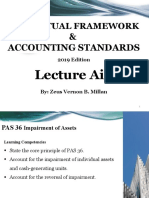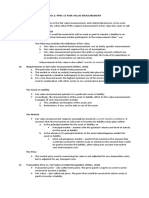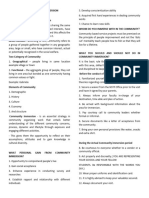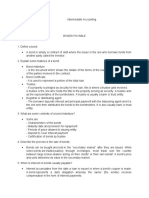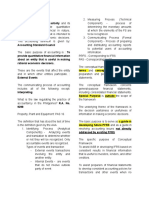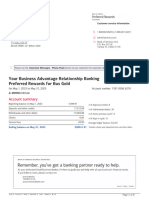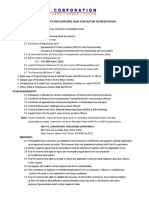Intermediate Accounting 2
Intermediate Accounting 2
Uploaded by
stephbatac241Copyright:
Available Formats
Intermediate Accounting 2
Intermediate Accounting 2
Uploaded by
stephbatac241Original Description:
Copyright
Available Formats
Share this document
Did you find this document useful?
Is this content inappropriate?
Copyright:
Available Formats
Intermediate Accounting 2
Intermediate Accounting 2
Uploaded by
stephbatac241Copyright:
Available Formats
(Intermediate Accounting 2) 3.
Liabilities held for trading such as obligations to
deliver financial assets borrowed by a “short
LECTURE AID
seller” (i.e. an entity that sells financial assets it
ZEUS VERNON B. MILLAN has borrowed and does not yet own).
Chapter 1 Current Liabilities 4. Preference shares issued with mandatory
Related standards: redemption.
PAS 1: Presentation of Financial Statements 5. Security deposits received that are to be
PAS 32: Financial Instruments: Presentation returned to tenants at the end of lease term.
PFRS 9: Financial Instruments
6. Obligations to deliver a variable number of own
Learning Competencies shares worth a fixed amount of cash.
Know the recognition criteria for liabilities and • The following are not financial liabilities
their essential characteristics.
Identify the characteristics of a financial liability. 1. Unearned revenues and warranty obligations
Know the initial and subsequent measurements that are to be settled by future delivery of
of financial and non-financial liabilities. goods or services, rather than cash.
Know how to classify liabilities as current and 2. Taxes, SSS premiums, Philhealth and other
noncurrent. payables arising from statutory requirements
Liabilities and not from contracts.
PAS 1 prescribes the basis for presentation of general 3. Commodity contracts that either cannot be
purpose financial statements to improve comparability settled in cash or which are expected to be
both with the entity's financial statements of previous settled by commodity exchange (e.g., coffee
periods and with the financial statements of other beans, gold bullion, oil, and the like). If a
entities. commodity contract is expected to be cash
settled, it will be included as financial liability on
Essential characteristics of a liability the part of the cash payor.
1. Present obligation (Legal or Constructive) 4. Constructive obligations. These obligations do
2. Arising from past events not arise from contracts.
3. Outflow of economic benefits
Recognition of liabilities
Financial liabilities
• An item is recognized as a liability when:
• A financial liability is any liability that is a
contractual obligation : 1. It meets the definition of a liability;
a. to deliver cash or another financial 2. It is probable that an outflow of resources
asset to another entity; or embodying economic benefits will result from
its settlement; and
b. to exchange financial assets or financial
liabilities with another entity under 3. The settlement amount can be measured
conditions that are potentially reliably.
unfavorable to the entity; or Measurement of financial liabilities
Examples of financial liabilities • Initial measurement – fair value minus
1. Payables such as accounts, notes, loans, bonds transaction costs, except financial liabilities at
payable and accrued expenses that are payable FVPL whose transaction costs are expensed
in cash. immediately.
2. Finance lease obligations.
• Subsequent measurement – amortized cost • On the other hand, non-trade payables are
(except financial liabilities that are classified as classified as current liabilities only when they
held for trading and those that are designated; are expected to be settled within one year.
these are subsequently measured at fair value)
Measurement of Non-financial liabilities
• Non-financial liabilities are initially measured at
the best estimate of the amounts needed to
settle those obligations or the measurement
basis required by other applicable standard.
• Examples:
1. Obligations arising from statutory requirements
(e.g., income tax payable)
2. Unearned or deferred revenues
3. Warranty obligations Dividends payable
4. Commodity contracts that either cannot be • Under IFRIC 17, the liability to pay a dividend is
settled in cash or which are expected to be recognized when the dividend is appropriately
settled by commodity exchange authorized and is no longer at the discretion of
the entity, which is:
Current liabilities
1. the date when the declaration of the dividend
Current liabilities are liabilities that are:
(e.g., by management or the board of directors)
1. Expected to be settled in the entity’s normal is approved by the relevant authority (e.g., the
operating cycle; shareholders) if the jurisdiction requires such
approval, or
2. Held primarily for trading;
2. the date when the dividend is declared (e.g., by
3. Due to be settled within 12 months after the management or the board of directors) if the
end of the reporting period; or jurisdiction does not require further approval.
4. The entity does not have the right at the end of
the reporting period to defer settlement of the
liability for at least twelve months after the
reporting period.
• All other liabilities are classified as noncurrent.
Trade and non-trade payables
• Trade payables are obligations arising from
purchases of inventory that are to be sold in the
ordinary course of business. Other payables are
classified as non-trade.
• Trade payables are classified as current
liabilities when they are expected to be settled
within the normal operating cycle or one year,
whichever is longer.
You might also like
- Como Que 33Document4 pagesComo Que 33Jaime Rodríguez CanoNo ratings yet
- Which of The Following Should Not Be Considered CashDocument5 pagesWhich of The Following Should Not Be Considered CashErica Florentino100% (1)
- HW 2. Problems Cash and Cash Equivalents - StudentDocument2 pagesHW 2. Problems Cash and Cash Equivalents - StudentAngelo TipaneroNo ratings yet
- CFAS Prelim Assessment - Conceptual FrameworkDocument5 pagesCFAS Prelim Assessment - Conceptual FrameworkTricia Mae JabelNo ratings yet
- Chapter-3-Proof-of-Cash 2Document2 pagesChapter-3-Proof-of-Cash 2Andrea CaparosoNo ratings yet
- Pas 36 - Impairment of AssetsDocument20 pagesPas 36 - Impairment of AssetsMichael Jack SalvadorNo ratings yet
- Chapter 11 Investments Additional Concepts LectureDocument13 pagesChapter 11 Investments Additional Concepts Lecturesantillan.arnaldo.duranNo ratings yet
- What Is The Difference Between An Adjunct Account and A Contra AccountDocument1 pageWhat Is The Difference Between An Adjunct Account and A Contra AccountDarlene SarcinoNo ratings yet
- Conceptual Framework and Accounting Standards 1 Overview of Accounting (Quiz 1)Document6 pagesConceptual Framework and Accounting Standards 1 Overview of Accounting (Quiz 1)Damayan XeroxanNo ratings yet
- PAS 36 Impairment of AssetsDocument8 pagesPAS 36 Impairment of AssetswalsondevNo ratings yet
- Quiz Chapter 4 Accounts ReceivableDocument9 pagesQuiz Chapter 4 Accounts ReceivableClene DoconteNo ratings yet
- Finman Test BankDocument3 pagesFinman Test BankATHALIAH LUNA MERCADEJASNo ratings yet
- Chapter 6 Cfas ReviewerDocument2 pagesChapter 6 Cfas ReviewerBabeEbab AndreiNo ratings yet
- Test Bank Pfrs 15 - CompressDocument44 pagesTest Bank Pfrs 15 - CompressKarren Claire C. VillaNo ratings yet
- CFAS - Lec. 12 PAS 29, 32Document31 pagesCFAS - Lec. 12 PAS 29, 32latte aeriNo ratings yet
- 11 - Bank Reconciliation NotesDocument3 pages11 - Bank Reconciliation NotesJann GataNo ratings yet
- International Accounting Standards: IAS 39 Final Instruments Recognition An MeasurementDocument49 pagesInternational Accounting Standards: IAS 39 Final Instruments Recognition An MeasurementMia CasasNo ratings yet
- Cfas Pas 41 AgricultureDocument4 pagesCfas Pas 41 AgricultureMeg sharkNo ratings yet
- Chapter 1 Business Combinations - Part 1Document22 pagesChapter 1 Business Combinations - Part 1Jane GavinoNo ratings yet
- CFAS Handout 01 - Corporation - Updated 01.21.2020Document23 pagesCFAS Handout 01 - Corporation - Updated 01.21.2020VanessaNo ratings yet
- Two-Date Bank ReconciliationDocument5 pagesTwo-Date Bank Reconciliationsweet ecstacyNo ratings yet
- PAS 12 Accounting For Income TaxDocument17 pagesPAS 12 Accounting For Income TaxReynaldNo ratings yet
- Intermediate Accounting IDocument35 pagesIntermediate Accounting ICrystal AlcantaraNo ratings yet
- Cfas Quizzes 1 3Document10 pagesCfas Quizzes 1 3mikamiiNo ratings yet
- Investment in Associates: PAS 28, PAS 29, and PAS 32Document5 pagesInvestment in Associates: PAS 28, PAS 29, and PAS 32Mica DelaCruzNo ratings yet
- Bonds Payable & Other ConceptsDocument7 pagesBonds Payable & Other ConceptsChristine Jean MajestradoNo ratings yet
- Answer Key - M1L4 PDFDocument4 pagesAnswer Key - M1L4 PDFEricka Mher IsletaNo ratings yet
- Isabela State University: MA 112 - Conceptual Framework & Accounting Standards - Chapter 1Document18 pagesIsabela State University: MA 112 - Conceptual Framework & Accounting Standards - Chapter 1Chraze GBNo ratings yet
- Ch. 1 - Conceptual FrameworkDocument1 pageCh. 1 - Conceptual Frameworkagm25No ratings yet
- Pas 23 - Borrowing CostsDocument8 pagesPas 23 - Borrowing CostsZehra LeeNo ratings yet
- A1-2BSA-01 P3 QuizDocument7 pagesA1-2BSA-01 P3 QuizBea EuniceNo ratings yet
- Week 4 - Lesson 4 Cash and Cash EquivalentsDocument21 pagesWeek 4 - Lesson 4 Cash and Cash EquivalentsRose RaboNo ratings yet
- CFAS Chapter 4 - Cash and Cash EquivalentsDocument3 pagesCFAS Chapter 4 - Cash and Cash EquivalentsAngelaMariePeñarandaNo ratings yet
- Chapter 10 Statement of Cash Flows PAS 7Document6 pagesChapter 10 Statement of Cash Flows PAS 7MicsjadeCastilloNo ratings yet
- RFBT - Chapter 1 - Bouncing Checks LawDocument3 pagesRFBT - Chapter 1 - Bouncing Checks Lawlaythejoylunas21No ratings yet
- Quiz-Lets FARDocument5 pagesQuiz-Lets FARSherlock HolmesNo ratings yet
- (Final) Acco 102 - Intermediate Accounting 1Document19 pages(Final) Acco 102 - Intermediate Accounting 1JONA CAÑESONo ratings yet
- AC 54 - Unit 2 (PFRS 13) Summary NoteDocument2 pagesAC 54 - Unit 2 (PFRS 13) Summary NoteNicky Joy CabasagNo ratings yet
- CFAS - Final Exam ADocument11 pagesCFAS - Final Exam AKristine Esplana ToraldeNo ratings yet
- Management-Science Introduction and Model of Cost, Revenue and ProfitDocument9 pagesManagement-Science Introduction and Model of Cost, Revenue and ProfitMalaque Carah Angela R.No ratings yet
- CFAS - PAS 7 - Statement of Cash FlowDocument14 pagesCFAS - PAS 7 - Statement of Cash FlowCarlo Lopez CantadaNo ratings yet
- FAR 0 Merged Handouts and ReviewersDocument31 pagesFAR 0 Merged Handouts and ReviewersKin LeeNo ratings yet
- Ch14-Non Current LiabilitiesDocument85 pagesCh14-Non Current LiabilitiesFatima Azzahra Saragih100% (1)
- Cash and Cash Equivalents (IA)Document9 pagesCash and Cash Equivalents (IA)rufamaegarcia07No ratings yet
- Current at The End of The Reporting Period. Comparative Figures For Prior Period(s) Shall Also Be RestatedDocument3 pagesCurrent at The End of The Reporting Period. Comparative Figures For Prior Period(s) Shall Also Be RestatedJustine VeralloNo ratings yet
- Midterms Quiz2 Take HomeDocument1 pageMidterms Quiz2 Take HomeAngeli Mendoza0% (1)
- NSTP 2 RiviewerDocument5 pagesNSTP 2 RiviewerZeny DalumpinesNo ratings yet
- Perpetual BowmanDocument19 pagesPerpetual BowmanEric AntonioNo ratings yet
- Chapter 7 Interm 1a Sol Man Millan (2019)Document20 pagesChapter 7 Interm 1a Sol Man Millan (2019)5555-899341No ratings yet
- RFBT 04 09 Law On SalesDocument71 pagesRFBT 04 09 Law On Salesmarin100% (1)
- Pas 37 ReviewerDocument2 pagesPas 37 ReviewerZarina BartolayNo ratings yet
- Bonds PayableDocument2 pagesBonds PayableanonymousjoeyNo ratings yet
- 1st Year - Financial Accounting and Reporting 1 PDFDocument14 pages1st Year - Financial Accounting and Reporting 1 PDFIts SaoirseNo ratings yet
- Module 1 - Cash and Cash EquivalentsDocument10 pagesModule 1 - Cash and Cash EquivalentsGRACE ANN BERGONIONo ratings yet
- Cfas ReviewerDocument6 pagesCfas Reviewerkeisha santosNo ratings yet
- Reviewer in Cfas - PFRS 11 - 15Document4 pagesReviewer in Cfas - PFRS 11 - 15geyb awayNo ratings yet
- Cash & Cash Equivalents Composition & Other Topics CashDocument5 pagesCash & Cash Equivalents Composition & Other Topics CashEurich Gibarr Gavina EstradaNo ratings yet
- Multiple ChoiceDocument6 pagesMultiple Choicetough mamaNo ratings yet
- Pas 10 - SummaryDocument1 pagePas 10 - SummaryBirdWin WinNo ratings yet
- Reviewer UPFRSDocument8 pagesReviewer UPFRSMhavy Pabanil Dela CruzNo ratings yet
- Intermediate Accounting 2 Prelim NotesDocument2 pagesIntermediate Accounting 2 Prelim NotesAndrea Leigh GarciaNo ratings yet
- Madhya Pradesh Paschim Kshetra Vidyut Vitran Company LTD.: G.P.H. Compound, Pologround, Indore (M.P.)Document1 pageMadhya Pradesh Paschim Kshetra Vidyut Vitran Company LTD.: G.P.H. Compound, Pologround, Indore (M.P.)tronborn100No ratings yet
- GFLK Qu VGK Yes 5 Ud 5Document4 pagesGFLK Qu VGK Yes 5 Ud 5Shree HedaooNo ratings yet
- ACC 102 Receivable FinancingDocument5 pagesACC 102 Receivable Financingwerter werterNo ratings yet
- Scale of ChargesDocument4 pagesScale of ChargesAshwin RajendranNo ratings yet
- IJMS Vol 3 Iss 2 Paper 9 538 542Document5 pagesIJMS Vol 3 Iss 2 Paper 9 538 542Rishi RajNo ratings yet
- Estmt - 2022 10 31Document9 pagesEstmt - 2022 10 31lzel8210No ratings yet
- How To Manage Your MoneyDocument14 pagesHow To Manage Your MoneyAmrik Singh100% (2)
- Zero To One-Book Review (By Divya Anand)Document27 pagesZero To One-Book Review (By Divya Anand)DEEPALI ANANDNo ratings yet
- International Finance - Assignment 1Document3 pagesInternational Finance - Assignment 1Betty MudondoNo ratings yet
- Information On Flexible Loan Product and JPY Lending Rates - 27 Jan 2023Document14 pagesInformation On Flexible Loan Product and JPY Lending Rates - 27 Jan 2023atca0102No ratings yet
- 02 Fnsacc517 Amit Aia220028Document14 pages02 Fnsacc517 Amit Aia220028amitchettri419No ratings yet
- Impact of SSI's On GDPDocument6 pagesImpact of SSI's On GDParnica_1989No ratings yet
- Nippon Life India Asset Management Profit & Loss Account, Nippon Life India Asset Management Financial Statement & AccountsDocument1 pageNippon Life India Asset Management Profit & Loss Account, Nippon Life India Asset Management Financial Statement & AccountsToxic MaviNo ratings yet
- 2024 Course ListDocument1 page2024 Course ListRajashekar VarkalaNo ratings yet
- Chapter-I: 1.1 Background of The StudyDocument21 pagesChapter-I: 1.1 Background of The StudyUtsav ShresthaNo ratings yet
- FFC - Accreditation - Checklist - Rev2 CodedDocument1 pageFFC - Accreditation - Checklist - Rev2 CodedSilver Ian UmaliNo ratings yet
- Activity 1 Intacc 1&2Document3 pagesActivity 1 Intacc 1&2Ynah GarciaNo ratings yet
- 2012 18 Debt Swap Irrevocable Undertaking PerformaDocument3 pages2012 18 Debt Swap Irrevocable Undertaking Performasarwan kumarNo ratings yet
- Kadodo Review (VL 4Document27 pagesKadodo Review (VL 4fardeenmohammed197No ratings yet
- TYBvoc Equity & Derivatives Market University ExamDocument2 pagesTYBvoc Equity & Derivatives Market University ExamMilind PatilNo ratings yet
- Manali Project Report - Customer SatisfactionDocument81 pagesManali Project Report - Customer Satisfactionroma hudedamaniNo ratings yet
- Perancangan Proyek Pabrik Pt. Sakti Inti Perkasa (Zenlatte) Oleh IntergazeDocument11 pagesPerancangan Proyek Pabrik Pt. Sakti Inti Perkasa (Zenlatte) Oleh Intergazenoverlina putri nisalNo ratings yet
- Gap Analysis QuestionsDocument2 pagesGap Analysis QuestionsEgemen ErtuganNo ratings yet
- Final T5 MKT 205Document2 pagesFinal T5 MKT 205Thenappan GanesenNo ratings yet
- Cat 345cl Technical SpecificationsDocument3 pagesCat 345cl Technical Specificationsdamon100% (71)
- 01 Create A Transparent and Defensible IT Budget StoryboardDocument136 pages01 Create A Transparent and Defensible IT Budget Storyboardkrishnamohan.chennareddyNo ratings yet
- Action Milano - CatalogueDocument36 pagesAction Milano - CatalogueAbhijeet AnkushNo ratings yet
- OPMAN Midterm ExamDocument2 pagesOPMAN Midterm ExamLalosa Fritz Angela R.No ratings yet
- A Marketing Presentation On TATADocument39 pagesA Marketing Presentation On TATAvijeetkumarNo ratings yet





